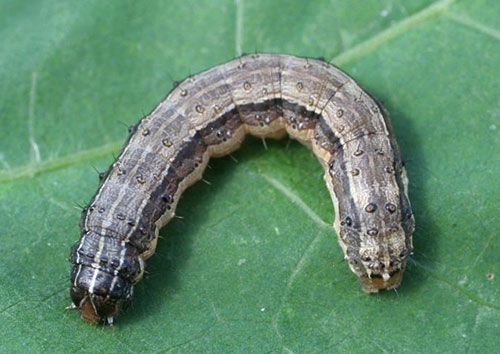You are here
Home ›Considerations for fall armyworm management in alfalfa and cover crops

NRCS advises of armyworm infestation in Allamakee County
by Virgil Schmitt, ISU Extension Field Agronomist in SE Iowa
The year 2021 has been an unprecedented year for fall armyworms, not just here in Iowa but other states as well. There have been many questions regarding how to manage fall armyworms in hayfields and cover crop fields.
Here is some background that may help explain some later comments.
• There are two strains of fall armyworms.
- The moths of the corn strain fly in from Texas and the Mexican Gulf Coast. Their favorite targets are corn, sorghum and cotton.
- The moths of the rice strain fly in from Florida and the U.S. Gulf Coast. Their favorite targets are rice, alfalfa, millets, forage grasses (including many cover crops) and turf. So, we have the rice strain this year.
The fall armyworms have a complete life cycle - egg, larva, pupa, adult (moth). This cycle repeats itself about every 30 days. It is heat driven, however. We had the first round in Lee and Des Moines Counties about 25 days prior to the events north of Highway 92, so the above-normal temperatures we had sped up the development a little. And as we cool down going into fall, the timeframe will be lengthened a few days.
Fall armyworms cannot overwinter here, so the first good freeze event will destroy them. Whether there will be a problem in another year literally depends on which way the wind blows.
Scout at sunrise or sunset. Fall armyworms tend to be nocturnal, so scouting at that time will give the best perspective of the current situation. If you are scouting in the middle of the day, you may need to look closer at the soil to see if they are present or not.
Now for the guidance:
Hayfields
If there is enough hay present to make a cutting worth harvesting, mow ASAP. We normally do not recommend cutting hay between the end of the first week in September and freeze down/winter dormancy (which is usually the last week of October) if the field is to be kept for hay the following year. However, the climatologists and meteorologists are very lockstep that this fall will run two to four weeks behind schedule, so there should still be time for full recovery (full recharge of carbohydrates in the roots) from taking the crop now. The later the mowing, the less is the likelihood of a full recharge of carbohydrates before going into winter dormancy.
Also, if the armyworm food source is eliminated (harvested), where will the larvae go for food? Adjacent forage fields, ditches, waterways, pastures, CRP, cover crops and farmstead lawns are likely targets, so there may be a battle on that front.
If there is not enough hay to make a cutting worth harvesting (either because of recent harvesting or if there is nothing but stems left in the field) and the larvae are less than 3/4-inch long and we are seeing more than two to three per square foot, spraying a pyrethroid insecticide (Warrior, Baythroid, etc.) should give a good kill and allow for good recovery of the alfalfa. If there are just stems left in the field, they do not need to be mowed off. Once light hits the crown, new shoots will be initiated.
If there is not enough hay to make a cutting worth harvesting and the larvae are over 3/4-inch long, it is probably best to let Mother Nature take its course. Once the larvae are over 3/4-inch long, they become harder to kill with an insecticide and they only have a few days left before pupating, turning to moths, and flying away to lay eggs elsewhere. Full grown larvae are about 1.5 inches long. At that point, they bury themselves in the ground, pupate, and then emerge as adults several days later. The adults will seek out lush growth and lay their eggs there, and the beat goes on until a killing frost destroys the entire population.
Cover Crops Fields
Do you spray? Where you may consider spraying is if you are planning on grazing or harvesting the cover crop for forage either this fall or next spring. With spraying, it’s important to consider the size of the larvae. Follow the recommendations above regarding the size of the larvae and the threshold.
For cover crop fields with extensive damage and that have been literally chewed to the ground, the question becomes, will the cover crop come back? The growing point of cereal grains would still be below the ground, especially if the field was drilled, as the growing point doesn’t move above the soil surface until it reaches the jointing stage, which occurs in the spring. This is good news because it means the plants will continue to grow.
However, as long as armyworms are still present in the field they will continue to eat off the new growth. Stand loss may be affected by how much regrowth there is before winter dormancy is induced.
Read more on fall armyworms and cover crops in this Iowa State University Extension Integrated Crop Management (ICM) Blog at https://crops.extension.iastate.edu/blog/rebecca-vittetoe/fall-armyworm-....

